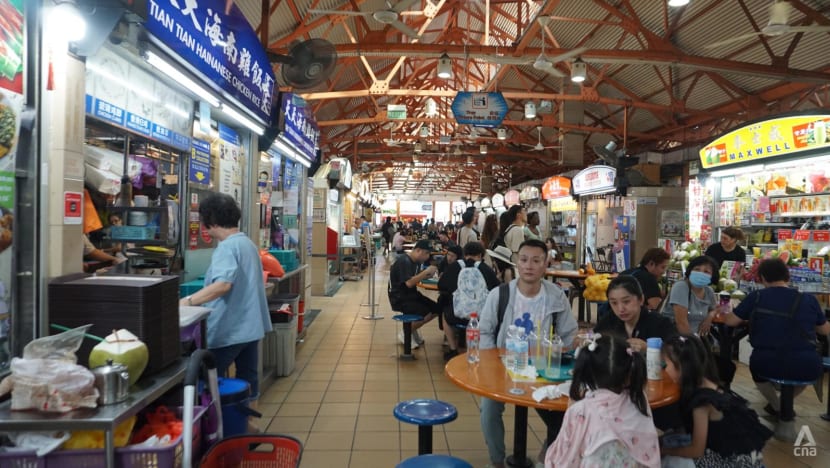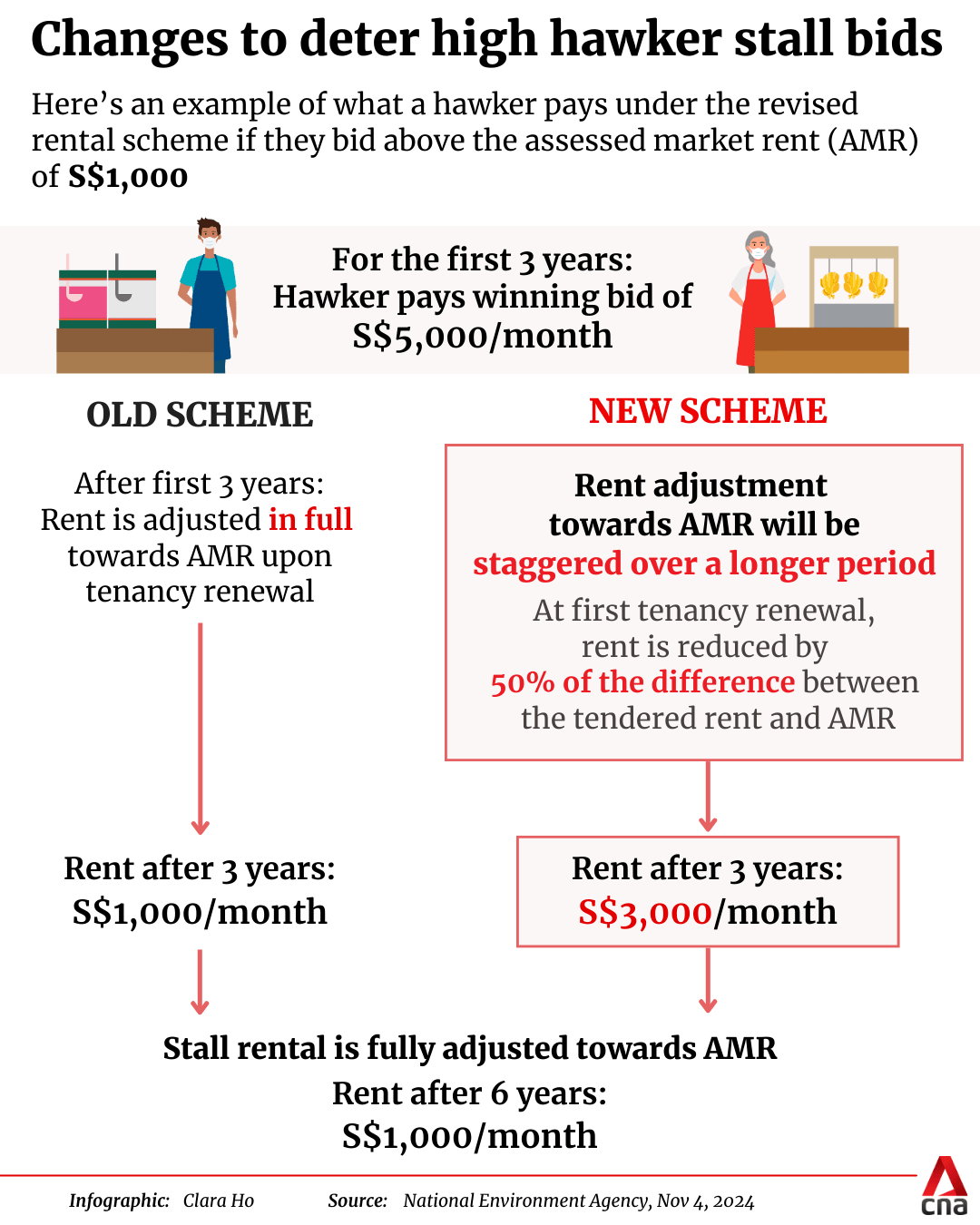Rental renewal policy for hawkers to be revised to discourage overly high tender bids
Some bidders may have tendered high bids to secure choice stalls at their preferred locations, but this is not the norm, said the National Environment Agency.


This audio is generated by an AI tool.
SINGAPORE: The rental renewal policy for successful hawker tenders will be revised from November to avoid overly high tender bids, announced the National Environment Agency (NEA) on Monday (Nov 4).
The downward adjustment of tendered stall rentals will be staggered over a longer period, instead of immediately at the first point of tenancy renewal.
This will take effect from the next stall tender exercise in November this year.
The adjustments will only apply prospectively, which means existing hawkers will not be affected, said Senior Minister of State for Sustainability and the Environment Dr Koh Poh Koon.
While most bids for vacant stalls are not that far from the assessed market rent, a "small percentage" can be quite high, especially at popular hawker centres, said Dr Koh, announcing revisions to the scheme on Monday.
"While the numbers of such bids are very small, we want to avoid such high bids becoming a norm in the future."
Prospective tenderers may put in overly high bids upfront to secure their preferred stall, knowing that under the current policy, their tendered rent will be adjusted downwards to the assessed market rent at the next tenancy renewal after three years, he added.
"But there are also some who do it without having a full understanding of the kind of business costs that are involved, resulting in them having difficulties paying high rentals that they cannot sustain in the long term."
Some bidders may have tendered high bids to secure choice stalls at their preferred locations, but "this is not the norm", said NEA in a separate press release.
In July, a hawker submitted a bid of more than S$10,000 (US$7,600) to rent a stall in Marine Parade. Ms Yang Ailan later told CNA that the new stall - her second one in Marine Parade Central Market and Food Centre - was worth the bid.
The S$10,158 bid by Ms Yang is the highest bid received so far in 2024, NEA confirmed.
In 2023, the highest bid received was S$6,810 per month for a hawker stall in Newton Food Centre.
HOW IT WORKS
Previously, the tendered stall rentals were adjusted down to the assessed market rent immediately at the first point of tenancy renewal - or after their first tenancy term, which lasts three years.
Now, the rental for such hawker stalls will be adjusted downwards by 50 per cent of the difference between their tendered rent and assessed market rent for the second tenancy term, NEA said.
For example, if a hawker successfully bids for a stall at S$5,000, they will pay that amount for the first three years.
Considering that the assessed market rent is S$1,000, they will then pay S$3,000 in rent under the revised scheme if they decide to renew their tenancy for a second term.
Finally, they will pay the assessed market rent at S$1,000 after they renew their tenancy from their seventh year, or their third tenancy term.

The median assessed market rent for non-subsidised market and cooked food stalls have remained at about S$320 and S$1,200 per month respectively since 2019, said NEA in a briefing on Monday.
Assessed market rent is considered annually based on factors including footfall, location, government policies specific to hawker centres and comparisons with similar hawker centres, the agency said.
Stallholders whose tendered rents are lower than the assessed market rent will continue to see their stall rentals adjusted upwards, said NEA, adding that this is moderated by the government and has not exceeded S$300 per tenancy term in recent years.
These revisions to the scheme will encourage "more prudent" bidding behaviour, added NEA.
"Only about 4 per cent of cooked food stalls in hawker centres today are paying rent at above assessed market rent," said the agency. Based on successful tender bids in 2023, about 56 per cent of the tender bids were above the assessed market rate.
“I don't think that these measures will disadvantage those who are bidding high, because if you actually are able to bid in a reasonable way that you feel is sustainable for your own business, then even if it doesn't get reduced to the assessed market rent, the cost compilation upfront by the hawkers should take that into account,” Dr Koh separately told journalists on Monday.
The median stall tender price for cooked food stalls was about S$1,800 in 2023, NEA said, adding that one in five cooked food stalls were awarded at tender prices at or below S$500 that year.
Median stall rent for non-subsidised cooked food stalls has remained relatively constant at about S$1,250 for the past 10 years, NEA added.
To help prospective bidders make more informed decisions, NEA will provide more information and online business cost estimation tools from 2025 to help them make better cost and revenue estimates.
Currently, bidders can access information on the five highest tender bids received for that stall in the past five exercises, as well as final tender results from past exercises. Resources on tendering for a hawker stall, such as brochures and FAQs, are also available.
About 200 stalls are put up for each tender exercise.
Editor’s note: A previous version of this article said that around 4 per cent of all bids for hawker stalls are high. NEA subsequently clarified that the 4 per cent refers to the proportion of cooked food stalls in hawker centres paying rent above the assessed market rate.

















